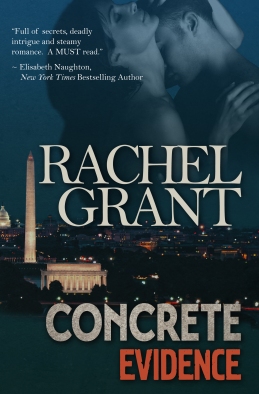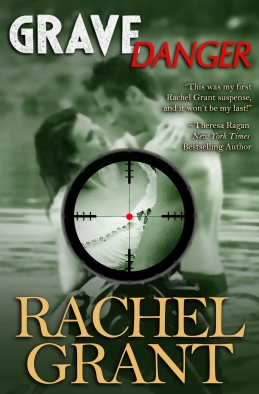The Kiss and Thrill blog, where this was originally published, will soon be disappearing, and I am republishing my Kiss and Thrill posts here to keep a copy. This one is from May 2013 and was written by Gwen Hernandez.
I wanted to be an archeologist for at least a year after I discovered Macchu Picchu (Peru) in a sixth grade textbook. I later realized I might not have the patience required for the job, but that didn’t stop my fascination with ancient sites and unearthed artifacts. Which is part of what I love about Rachel Grant’s books. They give the reader a glimpse into the real world of an archeologist. Add in some danger and steamy romance, and her stories have it all.
Rachel’s latest—out today!—Grave Danger, includes a determined archeologist trying to rebuild her reputation, a stalker, an unexpected find in the archaeological site, and a sexy small town cop who’s not sure if he can trust her, but can’t stay away. You won’t want to miss it!
She’s being stalked…
After struggling to recover from a career-crippling mistake, archaeologist Libby Maitland has landed the project of her dreams—a data recovery excavation in a picturesque, historic sawmill town. Tasked with digging up secrets of the town’s founding family, Libby soon learns that nothing in Coho, Washington, is as idyllic as it seems.
She’s barely settled into her new home when suspicious events make her believe she’s being stalked…
Or maybe she’s losing her mind.
Coho Police Chief Mark Colby can’t decide if Libby is crazy or if she has her own twisted agenda, but the deeper he delves into her past, the more intrigued he becomes. Even as he and Libby grow closer, he can’t quite let his initial suspicion go.
When Libby’s life is threatened, they must work together to determine if the truth about her stalker is buried in her past, or if the answers can be found in the layers of the excavation.
Read on for more about Rachel, archeology, and her books.
Gwen: Clearly your experience as an archeologist provides background for your stories, but was there something in particular that sparked Grave Danger? An incident? An article? A scene idea?
Rachel: The story for GD really flowed from the axiom “write what you know” – and while I’ve never been romanced by a hunky police chief or been stalked, I know a fair amount about prehistoric shell midden sites in the Pacific Northwest. I wanted to write a book about real archaeology, as it’s practiced in the United States, because most books with an archaeological storyline either focus on treasure hunting (which will get a real archaeologist blackballed) or contain other inaccuracies. So I started with the archaeological project, and plotted from there.
Avoiding spoilers, there is a discovery Libby makes during the excavation that is a real concern among archaeologists given the protocols we must follow in similar circumstances.
Is that vague or confusing enough? ?
Gwen: Hah, now everyone has to read it. ? This book was the first you’d ever written. I know you’ve made a lot of changes since the first iteration almost a decade ago, but what is it about this story that kept pulling you back in?
Rachel: I shudder when I think of that first draft. I set this story aside in 2008 so I could focus on writing Concrete Evidence and other, more suspense-y books, but I never really let this one go. This is my small-town-romantic-mystery, as opposed to my city-set-political-thrillers, and I’d love to write more books in this part of the romance genre. I’ve had the sequel plotted for years and I can’t wait to write it.
Gwen: I definitely want the sequel! In GD, Libby is an archeologist trying to restore her good name, and Mark is the chief of police of the small town where she’s starting a new project. What do you think makes these two characters perfect for each other?
Rachel: Libby is really attracted to confidence, because she’s lost confidence in herself after a professional and emotional setback, but Mark sees her strength—and the courage in her convictions that she thinks she lacks—from their first meeting. Plus they are both outsiders in a small, closed community, but they each need to understand and become members of that community as part of their respective professions.
To me, the town of Coho was a character—a beautiful, pristine historic gem on the outside, but with a dark and conflicted history that overshadows today.
 Gwen: Confidence is definitely sexy. Grave Danger—and your first release Concrete Evidence—both have archeologist characters, but the books aren’t a series. Do you have related stories for either of them in the works?
Gwen: Confidence is definitely sexy. Grave Danger—and your first release Concrete Evidence—both have archeologist characters, but the books aren’t a series. Do you have related stories for either of them in the works?
Rachel: I’ve had the sequel to GD plotted for a long time and look forward to writing it. I have two sequels to CE written and am working on a third. No promises yet on when those books will be released.
Gwen: Ooh, can’t wait for more in both series. Grave Danger takes place in a small sawmill town in Washington State, and Concrete Evidence was set in the big city—Washington, D.C. Do you find it easier to write small town or big city settings?
Rachel: The fictional small town was based on an historic sawmill town not far from where I live. This setting was easier simply because I could adapt the setting to suit my needs, but I loved writing the D.C. book too, because I lived there for two years and know the city well enough to write it with confidence. In CE, every scene (except for the ones set on fictional tribal-owned land) was set in a place I’ve visited at least once. Erica’s apartment in SW D.C. was my own, and the Bethesda office building was (not really) shockingly similar to the building I worked in.
Gwen: I definitely find it easier to write about places I’ve lived or at least visited. What’s the most interesting thing you ever found while working as an archeologist?
Rachel: Oh, that’s a hard one! In the Pacific Northwest, we don’t have pottery, we have woven basketry instead. Woven fibers decompose easily—they are only preserved in ideal conditions, very wet, or very dry—so finding prehistoric basketry is rare. Years ago, I worked on an excavation inside Porcupine Cave in Eastern Washington and caves and rockshelters have wonderfully dry preservation conditions. I found—in the screen, not in situ—a small fragment of a basket. That was really cool, but it was only about an inch across and something that wouldn’t trigger backflips for people who don’t know how rare and unique the find was.
Another exciting find was in SW Idaho, when I found a petroglyph on a rock face on the Owyhee Plateau. The petroglyph itself wasn’t all that exciting – it was a simple circle slightly larger than a softball – but still, it was the first time that particular petroglyph was recorded by an archaeologist and I was thrilled to have spotted it.
On a more bizarre note, I once dug a pit and found a rusted metal bucket and shovel head—evidence the site had been looted about a hundred years before.
Gwen: How cool to be the first to record a petroglyph! And I hadn’t thought of finding looting evidence, but then I guess that’s just another layer of artifact with its own provenance… Okay, one last question, like my experience after reading about Macchu Picchu, was there a particular incident that sparked your interest in archaeology?
Rachel: I was a senior in high school when I discovered Elizabeth Peters’ mysteries, and I (fondly) blame her for my decision to become an archaeologist.
Thanks so much for hosting me today, Gwen! I want to thank all the ladies at Kiss and Thrill for the fabulous support you all have given me over the last months.
Gwen: Thanks for sharing your new release with us. I can’t wait for more of your stories!
Pick up one of Rachel’s books today. C’mon, you know you want to.
Concrete Evidence
Amazon | iTunes | Kobo | Barnes & Noble
Grave Danger
Amazon | iTunes | Barnes & Noble

